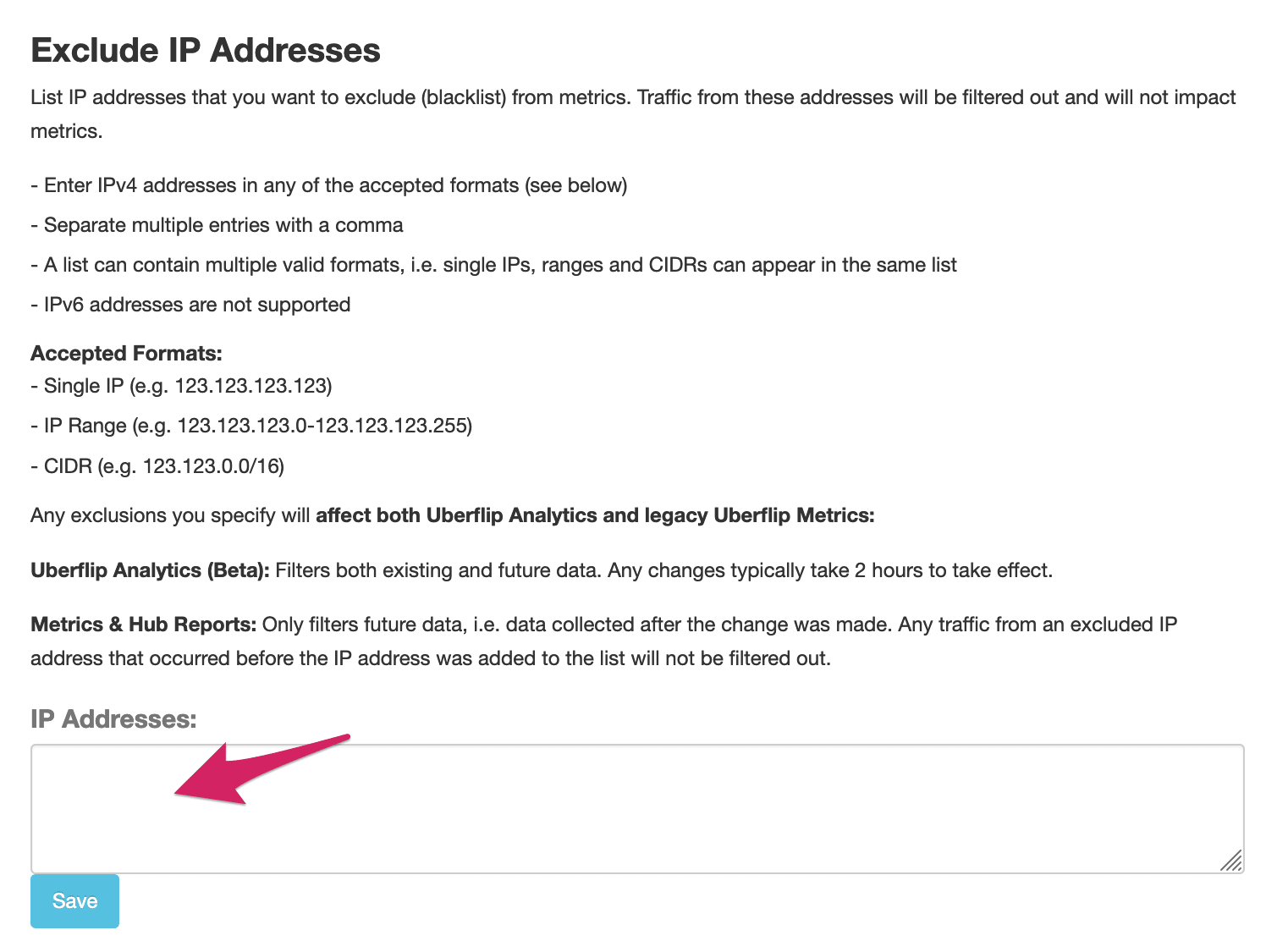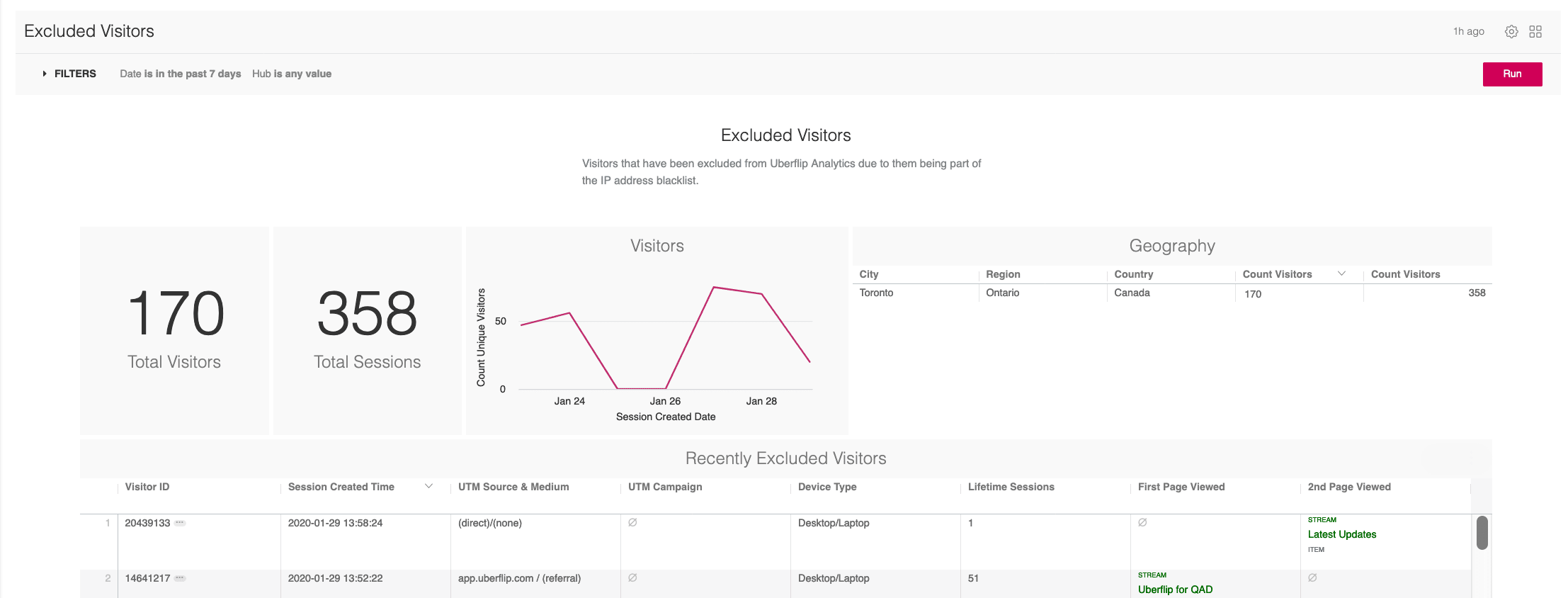Exclude Traffic From Specific IP Addresses in Uberflip Analytics
Get more useful data from Uberflip Analytics by excluding traffic from your own internal IP addresses (or any IP addresses of your choice).
Before You Begin
- To work with Uberflip Analytics, you need to be an Account Administrator, or have the Uberflip Analytics > View permission.
- To do this, you'll need to know your organization's IP address(es). You can usually obtain this information from your IT department.
About IP Address Exclusion
In most organizations, it's common for internal users to spend a lot of time browsing their own Hubs: aside from Marketing reviewing the content they create, Sales and Success teams will also routinely browse for content to share.
The problem is, all of this internal traffic throws off your metrics: your internal users tend to have different browsing habits from your external visitors, which can skew the data and make your metrics unreliable. To avoid this, you should set up Uberflip Analytics to filter out your organization's own IP addresses, which will exclude any data generated by internal visitors.
Tip
Do you work from home? Don't forget to add your own home IP address (and those of any coworkers who also work remotely) to your list of exclusions. (If you're not sure what your home IP address, simply Google "what is my IP?".)
If you do this, keep in mind that most home IP addresses aren't static, and may change from time to time.
Exclude Specific IP Addresses from Uberflip Analytics
You can specify any individual IP address or range of IP addresses to be excluded. The specified IP addresses must be IPv4 (IPv6 addresses are not supported), and can be added as single IP addresses, IP ranges, or CIDRs.
Any exclusions you specify will apply to both Uberflip Analytics and legacy Metrics. The exclusion rules work differently for each system:
- In Uberflip Analytics: IP address filters will be applied to future data only. Filters are non-destructive (filtered data is hidden, not deleted).
- In legacy Metrics: IP address filters are applied only to future data, i.e. after an exclusion is added. Any previously collected data relating to an excluded IP address will not be removed from your existing metrics. Filters are destructive (filtered data is deleted, and not recoverable).
To exclude IP addresses from Uberflip Analytics (and legacy Metrics):
- Log in to Uberflip and click on Analytics in the top menu.
- In the sidebar menu on the left, click on Analytics Settings, then click on Exclude IP Addresses:

- The Exclude IP Addresses menu will appear on the right. Use the IP Addresses text box to type in any IP address(es) that you want to exclude from Uberflip Analytics data.
- See the help text above the text box for accepted formats.

- See the help text above the text box for accepted formats.
- When you are finished, click on Save. Your settings will take effect immediately.
- If you later want to remove an IP address exclusion (i.e. to stop filtering out traffic for a certain IP address/range), simply remove it from the list, then click on Save again.
- For Uberflip Analytics: Data for previously filtered IP addresses will be visible again, including for the period when the exclusion was in effect.
- For legacy Metrics: Data for previously filtered IP addresses will only be visible for the period after the exclusion was removed (and before the exclusion was added). Data for the period when the exclusion was in effect was not collected, and is not available.
Excluded Visitors Dashboard
Because Uberflip Analytics filters out data for excluded IP addresses without destroying it, this data is still collected and remains available. The Excluded Visitors dashboard, which is located below the Exclude IP Addresses menu, displays metrics for only the IP addresses specified in your exclusion list:

This dashboard essentially shows the effects of the exclusion rules you have set up. As a result, it's useful for testing if the exclusions you have configured are having the intended effect.